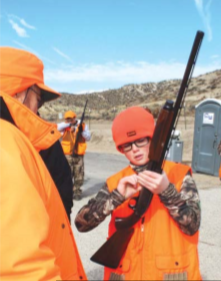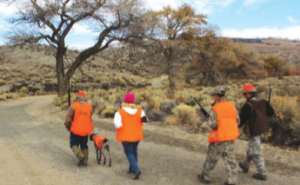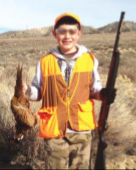Teaching Hunting is Kid Stuff
CDFW PROGRAM, VOLS PUTS YOUTHS BEHIND BIRD DOGS IN SEARCH OF PHEASANTS–By Tim E. Hovey
African proverbs have it that it takes a village to raise a child. While this statement may be somewhat antiquated in today’s “all about me” society, I still see great value in this adage when it comes to teaching kids to hunt.
Nowhere in the outdoor world is this more evident than in a youth pheasant hunt put on by our state’s resource agency.
I frequently attend these free youth and family pheasant hunts put on by the California Department of Fish and Wildlife during the fall. I go purely as an observer and really look forward to watching the joy and excitement of the participating kids as the day unfolds.
THESE HUNTS ARE geared towards introducing kids to the exciting world of upland game hunting. To dramatically increase the

potential for success and to introduce first-time junior hunters to the thrill of flushing game, pheasants are planted for each hunt in nearby fields. During hunter orientation, volunteers head out to the assigned fields and carefully release the birds for the young hunters.
While the ringnecks are being stocked, the new hunters attend an orientation given by the event’s coordinator, Nicholas Betchel. Nick goes over what he expects during the coordinated hunt and strongly suggests that kids and parents alike follow the safety rules and the code of conduct. Already dressed in blaze orange, the young hunters pay close attention to the instruction.
Nick is stern and to the point when it comes to the behavior he will allow at his hunting event. To be honest, in a setting where new hunters and anxious parents are present, there really is no other way to run a hunt like this.
Nick also inspects the shotguns that hunters bring to the event. He makes sure they are fully operational and that they properly fit the young hunter. He inspects the ammunition as well, making absolutely sure it’s appropriate for the specific firearm. Safety is the number one priority for Nick, and he wants to make absolutely sure that all hunters are well versed in proper firearm handling.
After the firearm inspection, event volunteers take the kids to an

area where they can quickly test their wingshooting. A portable target thrower is set up nearby, so each junior hunter can get a feel for tracking, following and shooting a flying target. This exercise also allows event personnel the opportunity to observe how the young hunters handle, mount and fire their shotguns. Volunteers provide helpful hints as the kids get an opportunity to put to the test what they’ve learned.
Once the birds are in place, kids are paired with passionate bird-dog owners and their dogs to run the field. These individuals volunteer their time and their well-trained dogs for the hunting weekend. The hunting group is then assigned a specific field to hunt. The volunteers will instruct the young hunters on when to shoot and when not to shoot for the safety of all involved, as well as the bird dogs. If things are not perfect, the instructor will reposition the hunters for safety.
As soon as the specific safety instructions are summarized, the hunting group will carefully head out into the field. This is a great opportunity for first-time hunters to witness the dedicated coordination between an experienced trainer and his well-trained bird dog.
Whistles and one-word commands guide the bird dog through the field with zigzag precision. The dog’s movements and behaviors will signal to his owner when game birds are close. And when the dog goes on point, beginners and veteran hunters alike will get chills.

THERE IS PROBABLY nothing harder in hunting than hitting a flying target with a shotgun. Many of the junior hunters participating in these fall hunts have never even seen a pheasant before, let alone taken a shot at one. The chicken-sized birds often flush mere feet from the hunter and there is nothing delicate about their departure. They are startling, explosive and extremely loud when they take flight. Depending on a hunter’s position, they will only have a few seconds to locate, track, lead and fire at the flushing bird. It’s no wonder that for many first-time hunters, a pheasant hunt can result in sensory overload.
I’ve watched dozens of these hunts from the safety of a distant hillside and I’ve been able to predict which kids will drop their birds and who may require a bit more practice.
However, the ones that fail to drop a bird at least get to experience an amazing hunt behind a trained dog and experienced volunteers. And those volunteers are quick to inform each hunter, successful or not, that hunting is not about the game killed, but about the overall experience, a very important lesson for young kids wishing to continue.
Back at the check-in area, volunteers instruct all the hunters on proper bird transport and cleaning for those lucky enough to have dropped a pheasant during the morning hunt. Special hunt event birds used for these hunts must be tagged prior to transport. After tagging, event volunteers show the group how to clean their birds, illustrating the connection between a hunted animal and the meat they’ll eventually consume. I especially like to observe this part of the event, since it’s where I often see kids watch in amazement as a feathered game bird is transformed into meat in a bag.
The once-quiet and nervous kids that entered the event that morning are transformed into excited and talkative individuals who’ve all shared the same amazing experience. They walk around with pheasant feathers in their hunting hats, and a few carry around bags filled with pheasant meat. The change in their attitude and behavior is great to see.
Nick and his dedicated group of volunteers are involved in every step of this hunting process, and each contributes valuable knowledge and experience to the event. They are patient, motivated and direct in an activity that requires all of these attributes in equal amounts. They understand that safety is the top priority and it is not to be compromised in any way. However, they also realize that well-instructed kids need to experience the fun as well, if they are going to continue on as hunters.
It’s clear to me that these hunts probably wouldn’t exist without this group of experienced and dedicated volunteers who help run them. They obviously have a real passion for passing on their knowledge and experience to the next generation.

LAST YEAR, DURING a lull in the activity I had a chance to talk with one of the volunteers who ran his bird dog for the junior hunters. After some brief pleasantries, he said something that I don’t think I’ll soon forget.
We were watching the next group of excited young hunters line up at their assigned fields. He lifted himself from his lawn chair and said, “I don’t care if I ever shoot another pheasant myself. I get more pleasure watching these kids on their first hunts!” That passion and desire for involvement is as important as the flushing birds, in my opinion.
If you or your family is interested in putting in for these fall hunts, visit CDFW’s website (wildlife.ca.gov) and search for the Special Hunts section. These hunts are free to the public and are a great way to get youth and family members involved in the wholesome outdoor activity. It’ll also give you an opportunity to meet some of the nicest and most knowledgeable individuals willing to answer any question you may have regarding upland game hunting.
And when you shake their hand, remember that during a weekend when they could be doing absolutely anything else, they’ve chosen to spend it with you and your family for free. Personally, I’m proud to know them. CS



